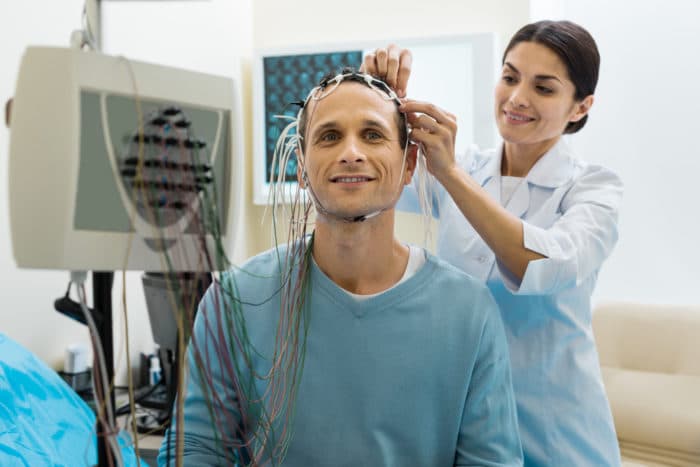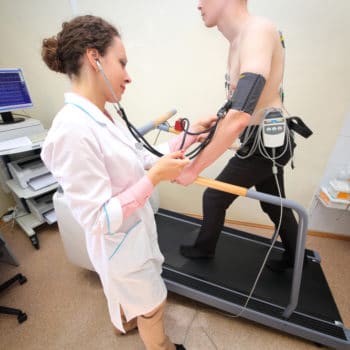Why We Love It
-
$45,730Potential Avg. Salary
-
23.2%Job Growth Rate
-
Growing DemandJob Outlook
-
Don't Take Work HomeCareer Attribute
A polysomnographic technologist supports the work of a clinical director or supervisor in order to provide a thorough evaluation and treatment of a wide range of sleep disorders.
Recommended Schools
What is a Polysomnographic Technologist?
Duties
The duties of a polysomnographic technologist include the following:
- Collect and create detailed records of patient information to track individual requirements like mental stressors, physiological status and medical history, to better determine treatment procedures in accordance with laboratory protocols.
- Observe the latest guidelines for data collection like the maintenance of Wakefulness Test, oxygen titration, Multiple Sleep Latency Test, oxygen titration, etc.
- Make note of routine observations like a patient’s different muscle and breathing activity, sleeping cycles, brainwaves, eye movements, etc., to accurately interpret polysomnographic findings.
- Stay up to date on the knowledge and skillset required to identify and successfully carry out age specific treatment, assessment and information sharing of geriatric, adolescent, adult and paediatric patient groups.
Day In The Life
As a polysomnographic technologist, you begin every shift, either morning or night, at a separate facility like a sleep lab. The office comprises of a large room with monitoring equipment for patients and comfortable patient rooms that are easily accessible. You would go over each case and meet with patients accordingly about their sleep disorder and progress updates.
Much of the day will be taken up by scheduled tasks like compiling and recording patients’ sleep data using an instrument like a PSG or polysomnogram. You may also have to help patients get ready for their polysomnogram and keep close watch while they sleep, to correctly interpret the results. If you work at a big clinic or medical care center, you may have an assistant or two to effectively manage things. It is not uncommon for some patients to suffer from sleep apnea, which would require treatment with approved methods.
A common issue patients face is self-consciousness or nervousness sleeping in a new environment under observation, with electrodes or sensors placed on their body. With your approachable and friendly personality, you would put such fears to rest and assure the patient that they are in capable hands. Once the patient is settled in their assigned room, you would go to your office and closely oversee the monitors placed to study their reactions while sleeping.
Work Schedule
As a technologist, you will typically be working during a patient’s sleeping time. Thus, work demands can extend to evening and night shifts as needed. Shifts can range between 10 to 12 hours while on weekdays, you may have to take on 2-3 night shifts. Depending on the size of the facility, you could be on rotating shifts with other professionals or have to work alone the entire time. Very rarely, there are daytime positions available when you have gained sufficient experience in the field. In this case, you would be expected in office early morning and leave by late evening.
It is important that you are comfortable standing for long periods of time, crouching and occasionally lifting up to 50 pounds. Since scoring sleep studies requires irregular work hours, you must function well at odd hours outside normal business timings.
Growth Of The Job
The sleep medicine industry is experiencing a boom recently with rapid technological advances and a renewed interest in alternate treatments for sleep disorders. A greater number of qualified people are looking to gain the right credentials for registering as a sleep technologist so competition is fierce.
Typical Employers
The job market for polysomnographic technologists is very promising but varies based on the region. Typical employers include academic institutions like colleges and universities, hospitals, medical clinics, sleep study centers, research institutes, etc.
Recommended Schools
How To Become a Polysomnographic Technologist
For an entry level position, you must possess at least an Associate’s Degree to gain an advantage. To be successful as a polysomnographic technologist, it is essential that you attend a formal training program. You can look into professional sleep training programs that bring aspiring candidates at the national level. The commitment for completion of such programs can vary widely, starting from an estimated few weeks to several months, which would also include an internship.
In addition, you should eventually complete a Sleep Technology Approved Resource (STAR) Program or a certification for greater opportunities. This usually involves completing an estimated 80 hours of classroom lectures and clinical training. Subjects you would focus on includes sleep disorders, data analysis, polysomnographic instrumentation and procedures, and equipment preparation.
Polysomnographic Technologist Salary Data
We’ve provided you the following to learn more about this career. The salary and growth data on this page comes from recently published Bureau of Labor Statistics data while the recommendations and editorial content are based on our research.
National Anual Salary
Low Range
$32,030Average
$45,730High Range
$70,340National Hourly Wage
Low Range
$15/hrAverage
$22/hrHigh Range
$34/hrHow do Polysomnographic Technologist salaries stack up to other jobs across the country? Based on the latest jobs data nationwide, Polysomnographic Technologist's can make an average annual salary of $45,730, or $22 per hour. This makes it an Above Average Salary. On the lower end, they can make $32,030 or $15 per hour, perhaps when just starting out or based on the state you live in.
Salary Rankings And Facts
#443 Nationally for All Careers
Highest Education Among Polysomnographic Technologists
- 4.8% Doctorate
- 7.5% Masters
- 21.3% Bachelors
- 14.4% Associates
- 31% College
- 19.3% High School
- 1.7% Less than High School
Job Growth Projections and Forecast
2014 Total Jobs
102,2002024 Est. Jobs
125,900Job Growth Rate
23.2%Est. New Jobs
23,700How does Polysomnographic Technologist job growth stack up to other jobs across the country? By 2024, there will be a change of 23,700 jobs for a total of 125,900 people employed in the career nationwide. This is a 23.2% change in growth over the next ten years, giving the career a growth rate nationwide of Below Average.
Growth Rankings And Facts
#36 Nationally for All Careers
What Companies Employ The Most Polysomnographic Technologists
| Industry | Current Jobs | New Jobs Needed | % Increase |
|---|---|---|---|
| General medical and surgical hospitals; private | 39,200 | 2,800 | 3% |
| Offices of physicians | 9,500 | 2,100 | 2% |
| General medical and surgical hospitals; local | 4,500 | -100 | 0% |













